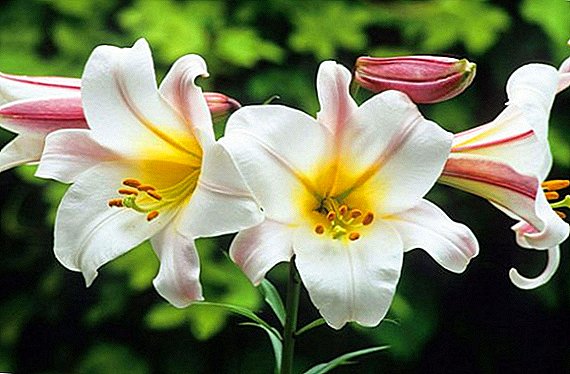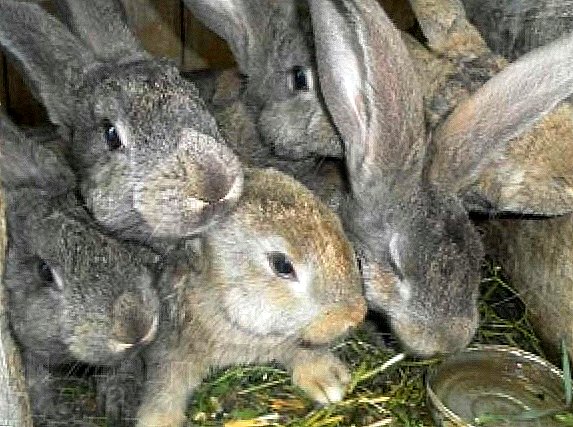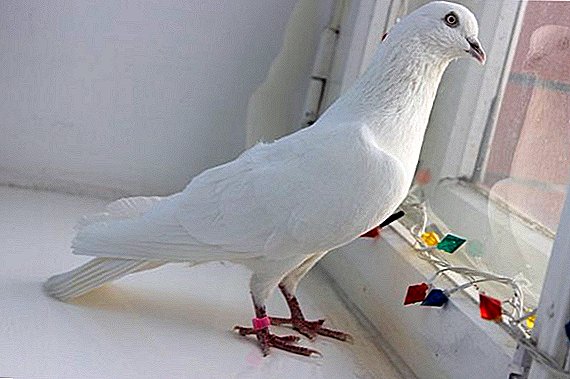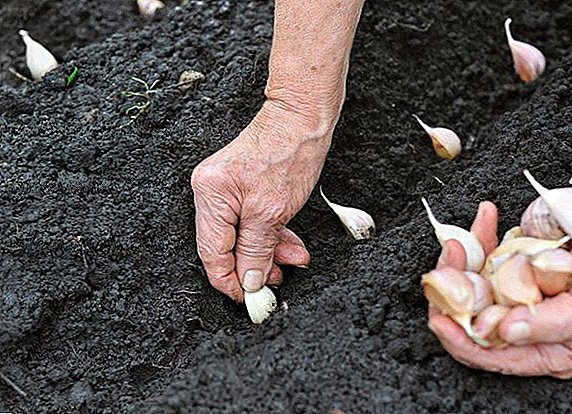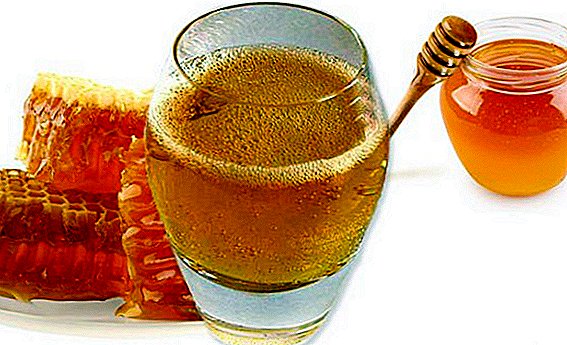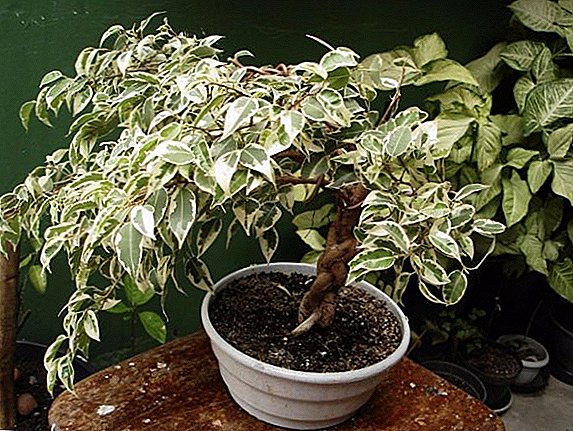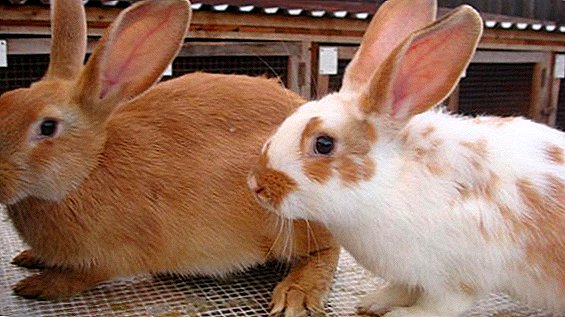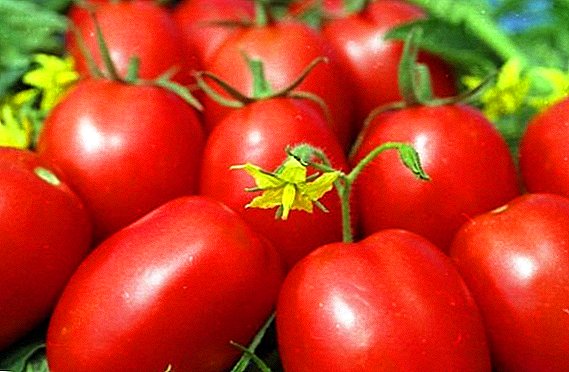 Tomatoes are among the most popular vegetables on the territory of the middle lane, so it’s hard to imagine a happy owner of a summer cottage who wouldn’t grow these wonderful fruits in his garden. Those who like tomatoes in the form of cream and who prefer not to complicate their lives with the equipment of complex structures for the garter of tall bushes, we suggest to pay attention to the relatively young, but already well-proven variety "Marusya".
Tomatoes are among the most popular vegetables on the territory of the middle lane, so it’s hard to imagine a happy owner of a summer cottage who wouldn’t grow these wonderful fruits in his garden. Those who like tomatoes in the form of cream and who prefer not to complicate their lives with the equipment of complex structures for the garter of tall bushes, we suggest to pay attention to the relatively young, but already well-proven variety "Marusya".
Variety description
It’s worth starting with the fact that “Marussia” is just a sort, not a hybrid, and for those who understand the difference, a lot has already been said.
Important! The variety is derived by long and painful artificial selection of the best of the best of its kind. Hereditary traits in such plants are firmly fixed (if, of course, to exclude the possibility of cross-pollination), and therefore such crops can be grown from seeds obtained from the previous harvest. A hybrid is a quick and, as a rule, a very successful result of crossing two different varieties, absorbing all the best from their parents. These plants always compare favorably with varietal plants in many respects, except for one thing: their excellent properties are not “inherited,” which means that the seeds will need to be bought every time.
“Marusya” received official recognition in 2007, when this child of Russian breeders passed state registration as a variety of tomatoes recommended for cultivation in private household farms, as well as on an industrial scale, both in open ground and under film. The variety is suitable for almost all regions of the middle zone.  The bush is low, from 50 cm to 1 m, determinant (growth stops after reaching a certain size), standard, that is, not needing a garter. Main escape one, sometimes two. Leaves of usual type, have saturated green color, foliage is good, during flowering and fruiting does not create an extra shade of ovaries, but at the same time protects them from possible sunburn.
The bush is low, from 50 cm to 1 m, determinant (growth stops after reaching a certain size), standard, that is, not needing a garter. Main escape one, sometimes two. Leaves of usual type, have saturated green color, foliage is good, during flowering and fruiting does not create an extra shade of ovaries, but at the same time protects them from possible sunburn.
To determinant varieties also include tomatoes "Katyusha F1", "Riddle", "Rio Fuego", "Klusha", "Star of Siberia", "Raspberry Giant".
The inflorescences are simple, the first flower brush is formed at the level of the sixth and seventh leaves and then after each leaf or two.
Gardeners and gardeners who have experience in growing a variety note its advantages such as:
- abundant and consistent fruiting;
- resistance to sudden temperature fluctuations;
- drought tolerance;
- heat resistance;
- the ability to get good yields under adverse weather conditions and inadequate care;
- high external and taste characteristics of fruits;
- the ability of the fruit for a long time and firmly hold on the branches, the lack of a tendency to fall;
- good yield yield;
- no problems with the garter;
- resistance to tomato-like fungal infections, such as verticillous wilt (wilt) and fusarium.
 Among the shortcomings it is worth noting only:
Among the shortcomings it is worth noting only:
- relatively short period of fruiting (not more than one and a half months);
- not very low yield.
Fruit characteristics and yield
According to the maturity of the harvest, the Marusyu should be classified as medium-early varieties: the first fruits appear approximately three and a half months after the sprouting of the seedlings, for a temperate zone this is approximately the end of July.
Fruits are plum-shaped, have medium size (60-80 g each) and a beautiful bright red color. Grow large brushes, up to ten tomatoes in each. Thus, up to 2 kg of crop can be harvested from each bush per season, which, taking into account the recommended planting scheme, is about 7 kg per square meter. m. Such indicators can not be called a record, because, according to the existing classification, high-yielding varieties of tomatoes involve picking at least 3 kg of fruit from a bush, but are compensated by other benefits of the variety.
Did you know? Wild tomatoes (they are still preserved in South America, where this plant comes from) have very tiny fruits - their weight does not exceed 1 g. For comparison: cherry tomatoes, which are considered the smallest, weigh 10 grams or more.
 A tomato has two or three chambers with a small number of seeds. The flesh is sweet and quite juicy, at the same time, the high content of dry substances in tomato ensures its good transportability and long-term storage. The moderately dense skin protects the fruits from cracking, which, together with the correct and identical form, makes these “creams” optimal for pickling and salting.
A tomato has two or three chambers with a small number of seeds. The flesh is sweet and quite juicy, at the same time, the high content of dry substances in tomato ensures its good transportability and long-term storage. The moderately dense skin protects the fruits from cracking, which, together with the correct and identical form, makes these “creams” optimal for pickling and salting.
We recommend to learn how to plant tomatoes according to the Terekhins method.
However, the excellent taste qualities of Marusia tomatoes make it possible to use them in a variety of ways - to use fresh, whole or in a salad, add to soups, stews and other dishes, twist them into tomato paste, ketchup or juice. In addition, the small size and plum shape of these tomatoes are ideal for drying (curing).
Selection of seedlings
Not every summer resident has the opportunity to grow seedlings on their own. For this, at least, you need a suitable place. Fortunately, there are people who are ready to take on this work, in other words, you can buy ready-made seedlings. In this case, however, you will have to be content with a much more limited variety selection, in addition, there is a risk of buying the wrong tomato that was announced. And yet, when it comes to annual vegetables, especially not a hybrid, the seeds of which are very expensive, and therefore the temptation to replace them with “something simpler” is very large, buying ready-made seedlings is quite justified.
Important! Do not deceive yourself: it is impossible to determine the variety of tomato by the appearance of the seedlings! At best, we can talk about the differences between tall (indeterminant) and short growing (determinant) plants, but even in this case, the only reliable indicator is the height of the flower brush.
 Hence the advice. If you are not sure of the honesty of the seller, do not focus on the variety, just choose healthy seedlings, following the following rules:
Hence the advice. If you are not sure of the honesty of the seller, do not focus on the variety, just choose healthy seedlings, following the following rules:
- all seedlings should have approximately the same size;
- bushes must be strong (optimal stem thickness - 4-5 mm, this is about the diameter of a pencil);
- the maximum height of young tomatoes is 30 cm, preferably less;
- the number of true leaves is from six to eight (for the indeterminant varieties, other norms apply);
- leaf color - dark green, without any signs of yellowness and dryness, including the cotyledon leaves;
- it is good if the first flower branch is already present on the bush (among other things, it is possible to judge about the variety of tomato in the place of its placement);
- all parts of the bush must be completely intact, no broken branches and torn leaves, especially signs of rot, mildew, wrinkled hair, blackened stem (do not forget to look at the leaves on the inside, this is where the "traces" of the pests are often hidden);
- it is better if the seedlings are sold in individual cups.
VIDEO: HOW TO CHOOSE A QUALITY CROWN You can not buy:
- too high seedlings (it will be hard to settle down after transplantation);
- actively flowering seedlings, especially with the ovaries (during the flowering period, the plant should already be in a permanent place in order to “concentrate” on preparing for fruit set);
- plants with very long branches (they were most likely grown in heat, which means that they are poorly hardened and can die when there is a sudden cold snap, which is very likely in the spring);
- too lush seedlings with bright emerald leaves, sometimes twisted down (this is an indicator of stimulation with nitrates, such plants later form a lot of green mass, but they give low yields);
- pale, sprawling seedlings with yellowed leaves.
Soil and fertilizer
“Marusya” would be best to feel on a sandstone or loam with a neutral reaction (pH level is within 5-6, but not higher than 6.5).
When planting plants, the acidity of the soil plays an important role. If you do not know what level of soil acidity in your area, we advise you to familiarize yourself with the ways to determine it.
 The best predecessors for tomato are:
The best predecessors for tomato are:
- cabbage, and any of its species (red, white, cauliflower, Beijing, broccoli, etc.);
- cucumbers, including exotic varieties (Mexican, Antillean, African, serpentine, red, etc.);
- squash or squash;
- watermelon;
- pumpkin - all kinds;
- melon;
- turnip;
- green onions;
- beet;
- carrot.
Important! Tomatoes should not be planted after any crops of the Solanaceae family (eggplant, potatoes, pepper (sweet and chilli), tomatoes).
 To get the most out of the land for tomatoes it is best to cook in the fall. To do this, you need to dig up the bed and make a tab of organic fertilizers - compost or rotted manure.
To get the most out of the land for tomatoes it is best to cook in the fall. To do this, you need to dig up the bed and make a tab of organic fertilizers - compost or rotted manure.
In the spring just before planting, it will only be necessary to supplement the “composition” with the necessary mineral additives, focusing on the potash and phosphorus components.
Growing conditions
Tomatoes are heat-loving crops that need very good lighting. The less shaded area will be selected for this plant, the faster the tomatoes will gain its bright red color and the sweeter their flesh will be.
Temperature "addictions" in this tomato variety are as follows:
- to start seed germination, the air must warm up to + 14-16 ° C;
- The best seedlings are formed in the range of +12 to +15 ° C at night and from +20 to +25 ° C during the day;
- optimum indicators for cultivation in an open ground - + 18-20 ° С at night and + 20-25 ° С in the afternoon;
- the bush stops growing if the temperature drops to +10 ° C;
- flowering and fruiting can not develop normally at air temperatures below +15 ° C or above +35 ° C;
- if the thermometer drops to zero, the plant in the open ground may die;
- besides, tomatoes do not like the differences between day and night temperatures (“Marusya” in this sense shows particular stability, but only in comparison with some other varieties).
 As for the relative humidity of the air, here for a tomato the same indicators as for a person are comfortable - 45-60%. In conditions of high humidity (both air and soil), the risk of plant infection with various fungal infections increases.
As for the relative humidity of the air, here for a tomato the same indicators as for a person are comfortable - 45-60%. In conditions of high humidity (both air and soil), the risk of plant infection with various fungal infections increases.
Growing from seed to seedlings at home
Growing tomato seedlings at home is troublesome, but fascinating and very rewarding. It is important to strictly follow the main rules, and "Marussia" will answer you with a friendly and confident growth.
Check out the best varieties of pink and yellow tomatoes.
Tomato seedling develops quite quickly, so it is very important that by the time of planting it does not reach too large sizes. Experts advise starting the process 60 days before the proposed landing in open ground, but this period may be too long. It all depends on how favorable are the conditions for the growth of seedlings. If you can provide seedlings with optimal temperature conditions and plenty of sun, it’s better to postpone a couple of weeks.
On average, you should focus on the end of February - the beginning of March.
Seed preparation
Quality material and proper seed preparation is half the success.
Seeds for seedlings can be prepared independently, but it is better to purchase them in a good specialty store, where the material has been carefully selected and properly prepared. But even in this case, before sowing seeds should be strengthened and protected from possible infections. The classic method of disinfection is keeping seeds in a weak solution of potassium permanganate for 15-20 minutes. (sometimes they use diluted with water in equal proportions aloe juice and other disinfectants of "handicraft production"), but it is much more effective to use modern biological preparations, such as, for example, "Fitosporin".
Find out what dosage of the drug "Fitosporin-M" should be used for the treatment of garden crops.
 This method of processing does not conflict with those that could be used by the seed producer (in contrast to the same aloe juice); in addition to the usual disinfection, it has a general stimulating effect on the future plant and significantly increases its yield.
This method of processing does not conflict with those that could be used by the seed producer (in contrast to the same aloe juice); in addition to the usual disinfection, it has a general stimulating effect on the future plant and significantly increases its yield.
To prepare the solution, use 4 drops of Fitosporin per glass of water. Prepared seeds are wrapped in gauze and dipped in solution for a day. After that, they need to be planted immediately, because the soaking has started the process of "spitting", and if the seed does not fall into the ground in the near future, the embryo will die.
Before disinfecting seeds, it is also useful to carry out their "inventory", rejecting those specimens that still do not germinate. To do this, just pour the contents of the bag into a glass of water, to which a pinch of salt has been previously added. Shake the liquid thoroughly and wait 5-7 minutes. All seeds that after the specified time will remain on the surface, you can safely throw away - they are empty. Subsequent work is carried out only with those specimens that have fallen to the bottom.
Shake the liquid thoroughly and wait 5-7 minutes. All seeds that after the specified time will remain on the surface, you can safely throw away - they are empty. Subsequent work is carried out only with those specimens that have fallen to the bottom.
Content and location
The best packaging for growing seedlings - special cassettes, sold in abundance in specialized stores. If this is not possible, you can use ordinary wooden or cardboard boxes with a depth of 7-10 cm, but it is less convenient to work with them.
Get acquainted with the peculiarities of growing seedlings in peat tablets.
For the subsequent picking, in any case, a larger individual container is required. Ideally, peat cups, which are planted in the ground along with a bush, will be used as such, which eliminates damage to the roots and minimizes the plant's stress from changing the place of residence. But it is quite expensive (especially if there are many seedlings), so you can use regular disposable cups and other containers of similar size.
Optimal conditions for growing tomato seedlings suggest:
- maximum natural lighting, and if it is not there - lighting up with the help of special lamps;
- abundant moisture;
- a sufficient amount of heat (optimal performance was indicated above).
Did you know? The record for growing tomatoes is China. The Celestial Empire accounts for about 16% of the total tomato crop produced in the world.

Seed planting process
For the cultivation of tomato seedlings, you can purchase ready-made soil mixture (universal or specially for seedlings), in this case no preliminary treatment is required for it. If you dug up the earth somewhere on the street, it, like the seeds, must first be decontaminated. To do this, you can pour it with boiling water or a solution of the same potassium permanganate (some prefer to ignite the soil in the oven). Such procedures have one major drawback: they kill the entire microflora, both harmful and useful. Therefore, it is better to still acquire the soil in the store or, in extreme cases, carry out soil disinfection at least two weeks before sowing the seeds, allowing the soil to stand in a cool place.
The seeding process is as follows. The prepared cassettes or boxes are filled with soil for 2/3, wet seeds are carefully laid out on its surface (you can use a knife or a toothpick), after which a thin layer of earth is poured.
Cassettes are convenient because one seed is placed in each cell. If a box is used, the seeds are laid out in rows with a gap of 2-4 cm apart.
VIDEO: SEED FOR SEEDS From above, the ground should be carefully sprayed and covered with a plastic wrap box or cassette to create a greenhouse effect, then transported to a pre-prepared sunny and warm place.
Care of seedlings
Tomatoes germinate pretty quickly. The first shoots appear within 6 days after sowing, and a couple of days later the process becomes widespread.
After the emergence of the first shoots should begin to prepare the shoots for a life without film. You must first remove it for a couple of hours during the day, gradually increasing the intervals.
Care of seedlings involves the constant moistening of air and soil.
Important! Until the seedlings are strong enough, it can not be watered.Moistening occurs only due to the superficial spraying of the soil, otherwise you can deepen the seed or damage the weak roots.
 It is also important to ensure that the air temperature is not too high, otherwise the seedlings will begin to grow actively upward and in the future it will be harder to survive the transplant.
It is also important to ensure that the air temperature is not too high, otherwise the seedlings will begin to grow actively upward and in the future it will be harder to survive the transplant.
When the seedlings form two true leaves, a pick is made. - replanting each bush into a separate, more bulk container. This should be done with the utmost care, grabbing as large an earthen ball as possible so as not to damage the roots (a teaspoon is well suited as an instrument for this purpose).  Approximately 2-3 weeks before the intended disembarkation, the seedlings begin to harden. At first, the cups are brought to fresh air during the daytime and left there for a quarter of an hour, gradually increasing the time spent in unusually cold conditions, until finally, several days before planting, the seedlings will not be able to safely endure the night under the open sky.
Approximately 2-3 weeks before the intended disembarkation, the seedlings begin to harden. At first, the cups are brought to fresh air during the daytime and left there for a quarter of an hour, gradually increasing the time spent in unusually cold conditions, until finally, several days before planting, the seedlings will not be able to safely endure the night under the open sky. 
Transplanting seedlings to ground
It is possible to replant "Marusya" in the open ground only when the temperature indicators (both day and night) reach the parameters necessary for the normal development of tomatoes. At the same time, the soil should warm up to at least +16 ° C to a depth of 20-25 cm. In addition, it should be remembered that unexpected night frosts, even short-term ones, can completely destroy already fully grown shrubs, so you should ask about before making a final decision.
The readiness of the bush for transplantation is evidenced by the appearance of the first flower brush on it, and it is very desirable to finish the process before the buds begin to open.
If at the time of formation of the brush on the street is still too cold, the spike should be gently pinch off. This will help delay the process of replanting without harm to the bush.
For transplantation, it is better to choose a not very sunny day, and it is better that the overcast weather also persists in the next few days, while the young tomatoes will undergo the process of acclimatization.
Important! People say: put in the mud - you will be a prince! Experience shows that seedlings planted under the pouring May rain, perfectly take root, despite the fact that the landing work in such conditions is very difficult and unpleasant.A low, but lush "Marusya" is recommended to be planted, keeping to a distance of 60 cm between the bushes and 70-80 cm - between the rows. There is a very effective modern scheme of the so-called wide beds, when between rows leave at least one and a half meters, but the bushes are planted more crowded. It is believed that this way you can achieve a significant improvement in yields, moreover, next year you can place a garden bed at the row spacing, thus, the soil will receive additional rest.
Agricultural technology of growing tomato seeds in the open ground
By the undoubted advantages of "Marousi" should be attributed to the lack of special difficulties with the care of the bushes. The minimum requirements involve only the correct formation of the bush, timely watering and feeding, as well as the control of weeds, possible infections and pests.
Outdoor conditions
"Marusya" is great for growing in the open field, and for the greenhouse. The choice, first of all, depends on the specific climatic conditions. In an area where there is little sun and heat, tomatoes will give a good harvest under the film, but in the southern regions they bear fruit well and without shelter.
The process of planting seeds in the ground
Usually tomatoes are grown through seedlings, but some gardeners prefer a simpler option. Seeds can be planted directly in open ground, but it should be borne in mind that only residents of those regions where stable warm weather lasts long enough can afford such luxury.  We calculate. "Marusya" begins to bear fruit after 3-4 months after germination, while the seeds for germination need daily temperature not lower than +20 ° C and night temperature not lower than + 12 ° C (and if the thermometer drops below +10 ° C, the growth process stop, and a sudden freezing of the soil will kill the tomato completely). If in your region such conditions can be provided even in the middle of May, you can risk planting Marusya in open ground right away, if not - she simply does not have time to shape the fruits before the arrival of the autumn cold.
We calculate. "Marusya" begins to bear fruit after 3-4 months after germination, while the seeds for germination need daily temperature not lower than +20 ° C and night temperature not lower than + 12 ° C (and if the thermometer drops below +10 ° C, the growth process stop, and a sudden freezing of the soil will kill the tomato completely). If in your region such conditions can be provided even in the middle of May, you can risk planting Marusya in open ground right away, if not - she simply does not have time to shape the fruits before the arrival of the autumn cold.
The technology of planting seeds in open ground is no different from sowing seedlings. After sowing, the bed is covered with film and observation of the process of germination begins. When the sprouts have formed two true leaves, they can be carefully transplanted to a permanent place according to the above scheme.
Watering
"Marusya" is demanding for regular watering, but does not tolerate stagnant water.
Important! Any tomatoes should be watered only under the root, pouring water on the leaves should not be. The best that can be done is to provide a drip irrigation system, it allows you to achieve the most efficient use of water and, moreover, in this way you can water the bed even on a sunny day, which is completely eliminated with ordinary watering.
 It is also important that the water for irrigation is not too cold, it can cause shock to the plant, especially if the air temperature is very high, which increases the contrast. As you know, a person's cold pores on the skin are narrowed, the same happens with the root system. As a result, it simply does not absorb moisture, and, therefore, watering does not reach its goal.
It is also important that the water for irrigation is not too cold, it can cause shock to the plant, especially if the air temperature is very high, which increases the contrast. As you know, a person's cold pores on the skin are narrowed, the same happens with the root system. As a result, it simply does not absorb moisture, and, therefore, watering does not reach its goal.
Tomatoes should be watered as the top layer of soil dries out, the regularity of the procedures depends on weather conditions (during the rainy season, watering can be stopped completely, on dry hot days - on the contrary, its intensity should be increased).
Soil loosening and weeding
In order that the soil around the plant does not dry out, after each watering it must be loosened. If watering is carried out in a droplet way, there is no need for such a procedure, which does not remove the issue of weed control, which not only impoverishes the soil, pulling the nutrients contained in it, but often are carriers of various infections.  Weeding problem can be solved by mulching the soil around the plant, mulch, in addition, will prevent the evaporation of moisture from the surface of the earth and thus slow down its drying.
Weeding problem can be solved by mulching the soil around the plant, mulch, in addition, will prevent the evaporation of moisture from the surface of the earth and thus slow down its drying.
Masking
Marusya, like most indeterminate tomatoes, does not branch very strongly, and yet most gardeners agree that the timely removal of lateral processes (stepsons) significantly increases the yield of the variety. But he has one peculiarity: only those branches that are located below the first flower brush should be processed in this way, all other shoots are left so that they can develop and branch.
Learn more about topping tomatoes in open field.
Garter
The undersized "Marusya" does not need serious support. But when the bush begins to bear fruit, especially if the correct care has ensured the achievement of maximum yield, under the two-kilogram weight of the ripening fruits, the plant may begin to collapse. To avoid this, it is worthwhile to provide him with at least the most primitive support. If there are not many tomatoes, it is easiest to stick a small peg next to each bush (to the height of the tomato or a little lower) and carefully tie the trunk to it at about 2/3 above the ground.  When mass planting, it is better to provide a horizontal garter (massive supports are driven in along the edges of the beds, and a wire is stretched between them, to which the stems or fruiting branches are tied up).
When mass planting, it is better to provide a horizontal garter (massive supports are driven in along the edges of the beds, and a wire is stretched between them, to which the stems or fruiting branches are tied up).
Top dressing
Top dressing is a very important element of care for tomatoes.
Important! Any tomatoes greatly impoverish the soil, which is why it must be constantly enriched in order for the plant to grow normally.The first feeding of seedlings should be carried out within two weeks after its landing in open ground. It is not recommended to do this before, so as not to burn the immature roots.
As fertilizer at this stage, organic matter is well suited - mullein or bird droppings.
After 10 days, the next dressing is carried out, this time mineral fertilizers are used - nitrogen, phosphate and potash fertilizers. For example, you can prepare a mixture of:
- ammonium nitrate (25 g);
- superphosphate (60 g);
- potassium salt (15 g);
- boric acid (1 g).
VIDEO: METHOD OF INCREASING THE TERMINATION ON TOMATOES Further fertilizing is made every two weeks, however, nitrogen fertilizers should now be excluded, because they lead to excessive formation of green mass, which takes all the powers of the bush, which leads to a significant decrease in yield.
We recommend that you feed the tomatoes with yeast.
Pests, diseases and prevention
Resistance "Marousi" to the most dangerous fungal infections is indisputable, but for prevention it is still worth treating the bushes with "Fitosporin", which, in addition to its fungicidal action, also protects the plant from various bacterial diseases.
Among the most dangerous for the variety of pests should be called slugs, whitefly and spider mites. Lime, tobacco dust, soap solution, and wood ash (chemicals, such as chlorophos, are used only in extreme cases) are effective for fighting slugs, Konfidor can deal with whiteflies, and Karbofos helps with whiteflies.
Harvesting and storage
While there are warm days in the yard, there are no questions with the timing of the harvest of tomatoes: tomatoes are removed when they acquire a bright red color. As a rule, we wait until the tomato becomes bright red, and then remove it from the sprig.
But after the arrival of cold weather, this rule ceases to act. All tomatoes, regardless of their ripeness, must be removed from the bushes before the first frost, otherwise the crop will be lost. At the same time, green tomatoes can be brought to maturity at home (this is especially true for fruits of a "milky" color, that is, those that have already begun to brighten), in addition, they are excellent for preparing a variety of preparations for the winter.  “Marusya”, due to the dense skin, is stored quite well, but for fully ripe fruits, it is still a very short time, a maximum of 10 days, and then only if it is properly stored. But green tomatoes can last much longer - from three weeks to two months.
“Marusya”, due to the dense skin, is stored quite well, but for fully ripe fruits, it is still a very short time, a maximum of 10 days, and then only if it is properly stored. But green tomatoes can last much longer - from three weeks to two months.
Did you know? French scientists for a long time conducted experiments, the purpose of which was to determine the optimal conditions for the storage of tomatoes. As a result, the following was established. Volatile substances that provide the unique aroma of a tomato are very quickly destroyed in a cold room (at a temperature of several degrees above zero), but at +20 ° C they are not only preserved, but they are also being actively developed. This is why tomatoes should not be stored in the refrigerator.In order to keep the harvest as long as possible, you need to adhere to the following rules:
- never wet the tomatoes before storing;
- use wooden or plastic cases for storage;
- put the tomatoes "ass" up, if possible, in a single layer, and between the fruits lay dry sawdust or peat;
- before laying, remove the pedicel from the fruit;
- keep the boxes warm.
Possible problems and recommendations
Agrotechnical cultivation "Marousi" is not particularly difficult, all the problems that may arise from a novice gardener, are equally relevant to any varieties of tomatoes. Below are some of these difficulties, as well as recommendations for eliminating them.
| Description of the problem | Possible reasons | Recommendations for their elimination |
| Flowers fall | Improper formation of the bush: the plant is too active in growth | Remove side shoots |
| Yellow leaves | Watering the leaves | Water the tomatoes at the root |
| For a long time the fruits do not ripen | Insufficient lighting | Try to remove the shading or choose a better place for the beds next year. |
| Fruits fall | Imbalance of trace elements in the soil | Adjust feed mode |
| Cracking fruit | Wrong watering mode | Do not over-wet the soil, especially after the soil has dried. |
Tomatoes "Marusya" - an excellent choice for any summer resident. Unpretentious and stunted plant gives a very decent crop of excellent tomato cream, which are equally well suited for fresh summer salad, and for a delicious billet for the winter.


